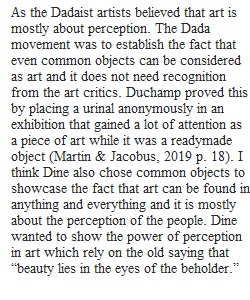


Q Preparation To prepare for this session's journal assignment, read chapter two well, examine Figure 2-1, Shovel, by Jim Dine, on p. 18 of the text. Consider the questions in the Perception Key on that page. NOTE: do not answer the Perception Key questions for this assignment—just read well and consider them. Then read the information below, and examine the picture of Dine's Five Feet of Colorful Tools, 1962 (below). Read the questions, then post your answers directly into the entry box below. Do not post your answers as an attachment. Background Jim Dine first gained critical interest in the early 1960s when he began to produce works of art that combined traditional elements of art, such as paint and canvas, with everyday objects, such as hardware, kitchen tools, and articles of clothing. He was especially interested in tools because his father owned a hardware store, where Jim worked as a teen and young man. Later in his career, he continued to portray tools, but through more traditional means of drawing and painting them. However, he also created a series of sculptures using tools embedded in glass. Below is a link to a picture of Five Feet of Colorful Tools, created in 1962 by using canvas, paint, a wood frame, and tools. Works like this are often identified as "mixed media," which means they combine several different types of materials. Here is a link to the work at New York's Metropolitan Museum of Art: http://moma.org/collection/browse_results.php?object_id=81620 Many students look at Figure 2-1 in the text and say, "That's not art - I could have done that!" This remark reveals the assumption that artists must exhibit special skills and an above-average ability to reproduce something in a recognizable way. However, the artists, like Dine, who became important in the art world of the 1960s were often trying to rebel against that standard. The question is: COULD you have done that? Or better yet, would you have thought of it? Five Feet of Colorful Tools is 5 feet tall, and the tools and paint are arranged at the very top. The canvas has a board attached at the top, and the tools hang from the board, with paint drips running down the canvas. Examine this picture, then answer all of the following essay discussion questions (number each 1, 2, 3): 1. Why do you think Dine chose this common subject matter and the title, Five Feet of Colorful Tools? 2. Do the tools match their shadows, or stencils (the paint that sprayed around them when they were painted)? What could be the reason for manipulating the elements in this way? Discuss the significance in the arrangement of elements in this work. 3. Is this art? When answering this discussion question, DO use the four steps / terms in Identifying Art Perceptually: Artistic Form, Participation, Subject Matter, and Content (on page 19.) Remember: your participation and response should clearly reflect your understanding of the chapter and specific content for this session.
View Related Questions